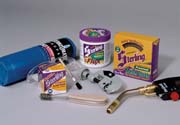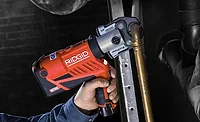The Lowdown on Solders and Fluxes
Solder and the contractors' soldering skills are to this day the glue that holds the industry together. Photo courtesy of Sterling Joining Technologies.
The phone rings off the hook some days with mechanicals, plumbers and wholesalers all looking for that magic metal alloy and flux to solve their copper joining needs. Taracorp and our manufacturers' representatives have been fielding these questions from all parts of the globe for more than a century.

Most of the callers know exactly what specification they're working under; the call is just to check with us to make sure all their bases are covered. The rest are either working under an outdated specification or no specification at all. In the solder category, leaded solder is nearly gone from the professional trade. A little is still sold-for industrial applications-but nothing close to the volume of lead-free alloys today.
Lead-Free Alloys
Not all lead-free alloys are created equal; performance is the deciding factor between the products on the market. At the bottom in terms of performance are the price-conscious alloys such as 95/5 (tin/antimony-ASTM B 32 'Sb5') and 97/3 (tin/copper) that offer very little in the way of strength and flow.
The workable range of these alloys is very tight, meaning there's more room for joint failure due to overheating. Once the temperature of the connection exceeds 475 degrees Fahrenheit, these solders will react to gravity, not capillary action. We've all seen vertical joints where the solder didn't run uphill or a horizontal joint where the leak is on the top. Both issues/failures are a result of heat and the narrow working range of 95/5 and 97/3 solders.
Like many other things in life, you get what you pay for. You may save a few pennies at the counter, but being called back to the site to fix a problem is going to cost you. Coincidentally, the "Sb5" alloy is the one alloy specification that's seen most often, and is the one most likely to be substituted for.
When the code changed from leaded to lead-free solder for potable water, the ASTM B32 specifications were changed to Sb5 throughout the industry. The high performing lead-free alloys will contain a mixture of Tin (Sn), Copper (Cu) and either Silver (Ag) or Selenium (Se).
Premium solders boast a number of advantages over the generic lead-free alloys.
Selenium-Based Alloys
Premium alloys with a high selenium content lower the melting temperature to 410ø F, very close the melting temperature of traditional leaded solders. When you add the lower heat tolerances of current ASTM B813 water-soluble fluxes to the equation, a lower temperature joining can have significant advantages. The alloy composition achieves quick flow and set up, a perfect combination for the majority of tube sizes joined today.
Silver-Bearing Alloys
Silver-bearing alloys are plentiful and available from nearly every manufacturer. Silver added to the alloy will exhibit an extended pasty (working) range, ideal for sweat connections on large diameter copper. The larger the tube, the more heat becomes an issue in the performance of the alloy. Silver-bearing solders typically have a 200 degree F workable range. Simply put, the alloy will melt around 440 degrees F and achieve capillary action at temperatures close to 640 degrees F. Once the connection temperature goes beyond 640 degrees F, the alloy will loose the ability to flow into the fitting cup.
It is important to remember with extended (pasty) workable ranges, more time is required for the solder alloy to set up and cool down. It takes very little time to sufficiently heat the pipe for soldering, far more time for the pipe to cool down with ambient room temperature. If you use more heat than necessary, the joint will stay liquid longer. The liquid solder will not support the weight of the tube and any disturbance will cause the solder to fall out. What you want is balance. Just enough heat to get you started, not too much heat that you spend time waiting on the solder to set up.
NSF 61 Certification
Regardless of your choice of premium alloy, selenium or silver-based, you should seek out products that have achieved NSF 61 certification. NSF 61 is an extra layer of protection that traces the product back to the manufacturing facility, and to the component materials. Alloys meeting this strict standard are assured to be safe for potable water applications under any circumstance, which cannot be said for all ASTM B32 lead-free alloys. Individual lot numbers are printed on each roll, allowing you to request lab analysis from the factory on the metal composition if there is ever a question from an inspector or customer.
Now, let's talk about cost. Obviously, lower grade alloys will run you a little less at the counter, and quite possibly, cost you a little more at the job site. Higher melting temperatures translate into more time and more gas used on each sweat connection, and the limited flow characteristics of low-priced alloys means more wasted product. Lower strength numbers can sacrifice the integrity of the joint, leading to that dreaded callback.
Do the math any way you like and you will find that choosing a premium alloy will only cost you a fraction more per connection. Any one pound spool will connect approximately 360 90ø fittings. A high-performing alloy with all the strength and flow you will ever need costs about 22 cents per fitting. Solder alloys whose performance is based solely on price will cost about 18 cents per fitting. Now, the trick question: How many bad connections does it take to bring down wallboard? We know the answer to that one too.
And Then There's Flux...
We wouldn't be doing anyone any favors if we didn't touch on the available fluxes to complete your job. Where there is flux, you will find solder and, unfortunately, the reverse of that is true also. Flux (and its residue) is a major consideration in the solder joining process.
There are two basic styles of flux, petroleum based and water soluble. Petroleum based fluxes are highly corrosive and require a chemical cleaner to remove residue from the internal and external piping system, not to mention cleaning your tools and yourself. I have watched many plumbers wipe joints with a wet rag after soldering to get rid of the flux. Guess what? That water won't remove the flux's petroleum base. What it will do is make a nice tight ring of flux close to the fitting that will eventually turn black.
ASTM B813 (water soluble) style fluxes are formulated with two distinct advantages. First there's a limit set on the corrosive nature of the product, far reduced from the non-specified petroleum based fluxes. Second, and most important, is that the post-soldering residue must be soluble in hot and cold water. Now that wet rag really works to remove flux from the outside of the pipe and water flow cleans the flux away from the inside. From a user's standpoint, that means no more black fingertips and the burning that petroleum flux can cause in small cuts.
One small point on "self-cleaning" fluxes. Every flux is self-cleaning because every flux contains chlorides that chemically etch copper. Petroleum fluxes need a little heat to clean, water soluble clean on contact-neither is formulated to skip the all important step of mechanical cleaning.
You will notice that ASTM B828 lists the steps for soldering copper. In the steps, flux is applied to CLEAN copper to prevent oxidation during the heating process and allow wetting of the solder alloy to the copper. The abrasive you combine with a little elbow grease creates small grooves in the pipe and fitting, essential for maximum bonding and strength.
In summary, your choice of lead-free alloy and flux will determine your sweat connection success. I have fielded enough calls to know that 95/5 and a large piece of 6-inch pipe just don't get along. Choose an alloy that offers you performance, it will cost you less over time. And choose an alloy that is certified to NSF 61 standards, this designation assures consumers and regulators that products do not contribute unsafe levels of contaminants to drinking water. If you have any questions about your current specifications or your alloy choice, as always, feel free to contact me directly.
"This article was originally posted on ww.reevesjournal.com."
Looking for a reprint of this article?
From high-res PDFs to custom plaques, order your copy today!









